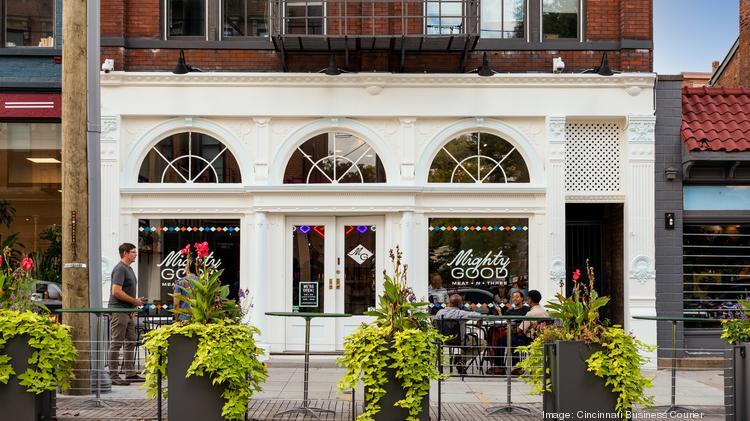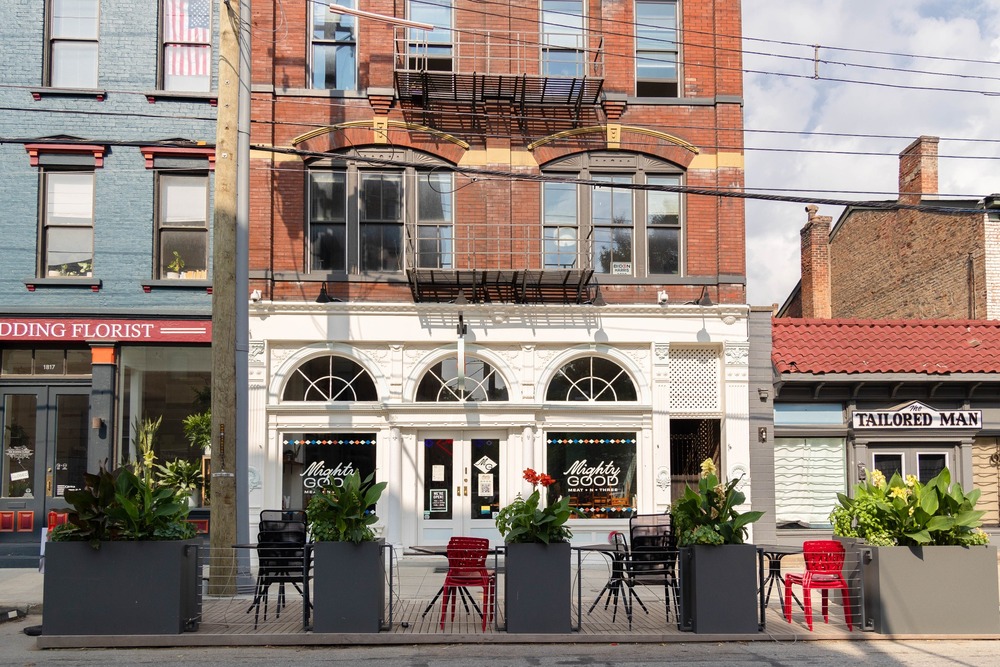
The Early Years
In the early 1860s, a two-story building, then listed as 641 Elm, was erected at where 1819 Elm now stands. It had a first-floor storefront and above and behind the commercial space, stretching all the way to Campbell Alley, were tenement apartments. Its first inhabitants in the 1860s included many German-speaking immigrants. Carl (or Charles) Wagner (or Wegner) was one such immigrant: he was a blacksmith, born in Prussia in 1830. Married to Anna, a German immigrant from Hanover, he had several children with her, including Charles, Anna, William, Fred, Henry, Frank and Sophia.
In 1862, Fabry Bonaparte started a coffee house on the first floor; the following year, Henry Eigbush, a German immigrant born in 1825, ran a similar operation. By the Civil War’s end, Henry Mueller, who also lived at the building, sold watches, clocks and jewelry out of the storefront. Briefly, around 1870, Jacob Hoefle (or Hoefele) (1840-1886) ran a millinery operation from 641 Elm. Jacob—who was 5’6” with blue eyes and dark hair—and his wife Louisa (1838-1921) were both German immigrants, born in Baden (he was from Karlsruh, Germany). By 1872, Jacob moved his business next door to 637 Elm where he also sold notions. Mid-decade, he worked from 623 Elm and later 621 Elm. In the early 1880s, he was also a saloon proprietor. He died in 1886 and left everything to his wife.
His widow Louisa continued to run a millinery shop at 617 Elm (what is now Crown OTR). Both of their work in the garment industry was representative of how huge numbers of immigrants, especially immigrant women, worked as seamstresses, dressmakers, milliners and embroiderers in the 1800s and early 1900s. From 1872 to the mid-1880s, German immigrant Jacob Buerger ran a shoe store in the storefront of 641 Elm. After Jacob Buerger, Charles Stalf then ran a boots and shoes operation briefly in the storefront. Members of his family had lived there since the early 1880s.
A New Building
In 1894, the “estate of George Slimer” demolished the two-story 641 Elm for a four-story brick building with a cast-iron storefront (what stands today). George Slimer was a German-French immigrant, born in 1820 in Elsas, France. He immigrated to Cincinnati when he was ten years old and as a young man became a butcher. George Sr. died in 1893, and thereafter the executors of his estate constructed 1819 Elm.
William Miller (1843-1908) and his son William Jr. (1870-1942) were the craftsmen behind the building, for they were the general contractors. Brand new in 1895, after William finished the project, 1819 Elm’s storefront first housed a stove manufacturing company at the turn of the 20th century, run by Louis H. Schmidt. A German immigrant born in 1850 in Hanover, Louis immigrated to the U.S. as a young boy in 1860, trained to be a tinner and later owned his own company that made stoves (most stoves in this time were cast-iron). He married Louisa Becker in 1871 and had with her nine children, six of whom—Louis, Emma, Charlotta, Charles, Ella, Edna and Clara—lived past infancy. From the early 1900s until the early 1920s, the Guarantee Deposit Bank set up a branch in the storefront of 1819 Elm; its other locations were at 1504-1508 Vine Street (today, a parking lot) and 16 East 7th.
The storefront cornice at 1819 Elm, to this day, boasts the name of this bank. During this time, many—many—families lived upstairs. As much as two-story 641 Elm was a tenement building, its four-story successor also housed over a dozen families within a leasing period. The bank was organized in 1900 with Edwards Ritchie (1859-1925) as the president, John R. Cheeseman (1847-1925) as the vice president, J. W. Crothers as the treasurer and J. B. Laumann as the secretary. A lawyer by profession, Edwards was born in 1859 in Greenfield, Ohio to a Scottish reverend, Andrew, and his wife Mary (Gray). Andrew was born in Aberdeenshire, Scotland, and immigrated to the U.S. in 1846. He and his wife Mary (Brice) (1868-1903) married on November 8, 1892. They had four children, Herbert (1894-1963), Clementine (Taylor) (1900-1962), David (1901-1955) and Mary (Hopple) (1902-1954) (their youngest daughter Mary attended Smith College, making her one of the rare young women in the early 1900s with a college degree). Edwards and Mary raised their children in Wyoming where Edwards was quite involved, having served on its health and school boards. As a bank president and lawyer, Edwards was, predictably, a wealthy man. He was also, for a time, the secretary, treasurer and general manager of the Cincinnati and Kentucky Southern Railroad.
In the first of 1924, J. Quarter & Sons acquired the building from a Sam Greenwald and then sold it to a Sam Povaner. The new owner advertised the storefront for rent as the Guarantee Trust Company closed its doors at that location. 1819 Elm had by then—as local newspapers advertised—inside toilets as well as gas and electric service, making one of the nicer tenements in the neighborhood. Soon, the commercial space became home to Leonard Rebmann’s Cincinnati Dry Cleaners’ Equipment Company. Born in 1888, Leonard was a second-generation German immigrant, like his wife Bertha (Heimerdinger). After their marriage in 1910, they had one son, Donald, born in Ohio. Leonard had spent his younger years as a clerk and book keeper at a factory and mill, eventually owning his own dry cleaning equipment company by the Great Depression. He passed away in 1955. By World War II, janitors’ supplies were sold at 1819 Elm.
John W. LeCraw (1869-1948) was the proprietor and ran his business by Findlay Market until the early 1950s. John was born in 1869 in Indiana; his wife Jessie (Thompson) (1874-1961) was born in 1874 in Ohio. They wed in 1895 and did not have children. John worked various jobs throughout his life: he was a life insurance agent, a clerk at a feed store, later a brush manufacturer—before running his own janitors’ supplies business.
In 1943, the Big Four Building & Savings Company sold the building to Max Sirkin (1910-1960) who quickly transferred it to real estate agent Abram Fox (1893-1967) who held onto it until 1965. Abram was a Polish Jewish immigrant who came to the U.S. in 1913 from the Russian Empire—just before it collapsed during World War I and the Russian Civil War. His wife Mathilda (1892-1978) was similarly a Polish Jewish immigrant; she came to the U.S. in 1921. As parents, they raised Freada, Bertha and Sylvia here; Freada was born in Russia and immigrated with her mother. The family lived in Avondale like many other Jewish Cincinnatians. From 1954 to 1957, Solway’s Exchange Store was in the storefront of 1819 Elm. Solway’s Furniture Store was where the Leader Furniture building is today (Leader Furniture moved into the northeast corner of Elm and Elder in 1963).
Solway’s used 1819 Elm’s storefront as a consignment shop for gently used furniture, where people could both drop off used furniture for money and find reasonably priced goods for purchase. Solway’s in general was a Findlay Market favorite and staple; Harry Solway, its proprietor, offered installment payments that allowed a variety of customers to afford new or used furniture. Harry Solway (1898-1956) was born in 1898 in Smolensk Oblast in the Russian Empire. As a Russian Jewish immigrant, he arrived in the U.S. in 1912. In Cincinnati, he started a humble furniture store in 1920 with just three employees. That same year, he wed a German-Lithuanian woman, Anna (Hellman) (1897-1941), and had Tamara, Ethel (Peal), Norma (Ehrlich), Barbara (Cohen) and Carl with her. (After Anna’s death in 1941, he remarried a woman named Sylvia). He was an active Findlay Market Association member—and president at one point—in addition to being an active member—and for a time vice president—of his synagogue, the Louis Feinberg Synagogue in Avondale. He was a member of the National Retail Furniture Dealers Association, the Retail Stores Service Syndicate and the Queen City Furniture Club. Additionally, he was a Mason.
Throughout the mid-20th century, apartments inside 1819 Elm were advertised for rent to local Cincinnatians. Unlike other buildings in Cincinnati’s urban core, rental units here were still filled as the building did not suffer from vacancy until much later. Prior to the mid-1960s—and major civil rights victories—apartments at 1819 Elm were rented to white tenants only. In the early 1960s, 1819 Elm was used by the Free Pentecostal Church. Apartments were still maintained above the storefront and in the rear.
In 1965, Bertha Smith bought the building. Alvin was the son of Harry L. Meisel (1895-1972) and Rose (Kohn) (1907-2006). Harry was born in Batesville, Indiana, and grew up in Covington, Kentucky, raised there by his Jewish immigrant parents. Harry’s father Michael and mother Agnes had immigrated in the 1880s from Poland (then tsarist Russia). His father worked as a rag dealer; his mother Rose, born in Chickasha, Oklahoma, also came from a Russian background. After marrying in 1927, Harry and Rose started a family in Cincinnati: Alvin “Bunny” was born in 1928. Harry and Rose ran an antique shop on East Pearl Street in downtown Cincinnati which Alvin, as he grew up, assisted at (Riverfront Stadium was built on top of this location). During World War II, antiques were a hard commodity to come by, so Harry and Rose switched to selling new furniture. In 1955, they moved into 1801-1803 Elm with their Globe Furniture business. In addition to furniture, appliances were also sold at the Elm Street store. Harry Meisel passed away in 1972.
Thereafter, Alvin took over the family business, including expanding to 1819 Elm in the late ‘80s. 1819 Elm, though, mostly sat vacant throughout the 1980s; people no longer lived upstairs. In the late 1990s, the New Prospect Baptist Church bought 1819 Elm; they held onto it until 2013. Throughout much of that ownership, the building was unlisted in city directories. Recently, though, in early 2019, it opened its doors again as Social OTR—a non-profit and culinary-training restaurant operated by the Corporation for Findlay Market in partnership with CityLink.
Images

